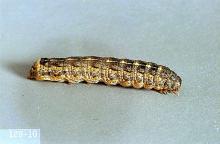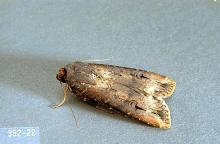Includes
Black cutworm (Agotis ipsilon)
Variegated cutworm (Peridroma saucia)
Pest description, crop damage and life history
See:
Common Pests of Vegetable Crops
Management-cultural control
Weed control is important. Lambsquarters and wild mustard attract egg-laying females and provide a source of food for larvae. Fall tillage can help destroy overwintering pupae.
Home gardeners: Control weeds, grasses, and debris in the vegetable garden that provide cover; hand-pick cutworm larvae, using a flashlight to find them, if practical. Scratch the soil at the base of plants to find larvae in the daytime.
Management-chemical control: HOME USE
Apply any one of these materials to the soil surface at first sign of cutworm activity. Consult label. Minimum preharvest interval (PHI) varies with crop. Difficult to control. Where cutworms are on the soil surface, a carbaryl drench (when bees are not present) may help.
- azadirachtin (neem oil)-Some formulations are OMRI-listed for organic use.
- Bacillus thuringiensis var. kurstaki (Btk)-Some formulations are OMRI-listed for organic use.
- bifenthrin (sometimes as a mix with zeta-cypermethrin).
- carbaryl
- cyfluthrin
- deltamethrin
- esfenvalerate
- kaolin-Applied as a spray to foliage, it acts as a repellent to some insect pests. Some formulations are OMRI-listed for organic use.
- permethrin
- plant-derived essential oils (rosemary, peppermint etc.)-These have some efficacy against cutworm. Some formulations are OMRI-listed for organic use.
- pyrethrins-Some formulations are OMRI-listed for organic use.
- spinosad-Some formulations are OMRI-listed for organic use.
- zeta-cypermethrin
Management-chemical control: COMMERCIAL USE
- Bacillus thuringiensis (Javelin) at 0.12 to 1.5 lb ai/A. PHI 0 days. REI 4 hr. Acts slowly. May need multiple applications. Add an appropriate spreader-sticker to enhance control. Most effective on small larvae. Some formulations are OMRI-listed for organic use.
- beta-cyfluthrin (Baythroid XL) at 0.007 to 0.013 lb ai/A. PHI 0 days. REI 12 hr. Do not exceed 0.088 lb ai/A per season. Retreatment interval 7 days.
- bifenthrin (Brigade WSB, Sniper) at 0. 05 to 0.1 lb ai/A. PHI 3 days. REI 12 hr. Do not exceed 0.3 lb ai/A per year. Do not make more than two applications after bloom. Retreatment interval 7 days.
- bifenthrin/zeta-cypermethrin (Hero EW) at 0.04 to 0.1 lb ai/A. PHI 3 days. REI 12 hr. Retreatment interval 7 days. Do not exceed 0.4 lb ai/A per season. Limit 2 treatments after bloom.
- carbaryl (Sevin 5 Bait) at 1 lb ai/A. PHI 3 days. REI 12 hr. Retreatment interval 7 days. Do not exceed 6 lb ai/A per season. Limit 6 treatments per year.
- Chromobacterium subtsugae (Grandevo) at 0.3 to 0.9 lb ai/A per 100 gal. PHI 0 days. REI 4 hr. OMRI-listed for organic use.
- cyfluthrin (Tombstone) at 0.013 to 0.025 lb ai/A. PHI 0 days. REI 12 hr. Do not exceed 0.175 lb ai/A per season. Retreatment interval 7 days.
- deltamethrin (Delta Gold) at 0.012 to 0.028 lb ai/A. PHI 3 days. REI 12 hr. Retreatment interval 3 days. Do not exceed 0.168 lb ai/A per season.
- dinotefuran (Scorpion 35SL) at 0.05 to 0.18 lb ai/A foliar or 0.23 to 0.27 lb ai/A soil. PHI 1 day foliar; 21 day soil. REI 12 hr. Retreatment interval 7 days. Do not exceed 0.266 lb ai/A foliar or 0.532 lb ai/A soil per season.
- esfenvalerate (Asana XL) at 0.03 to 0.05 lb ai/A as seedling spray. PHI 3 days. REI 12 hr. Do not exceed 0.25 lb ai/A per year.
- gamma cyhalothrin (Declare) at 0.01 to 0.015 lb ai/A. PHI 1 day. REI 24 hr. Retreatment interval 5 days. Do not exceed 0.09 lb ai/A per season.
- lambda-cyhalothrin (Warrior II) at 0.02 to 0.03 lb ai/A. PHI 1 day. REI 24 hr. Retreatment interval 5 days. Do not exceed 0.18 lb ai/A per season.
- lambda-cyhalothrin/thiamethoxam (Endigo ZC) at 0.064 to 0.072 lb ai/A. PHI 1 day. REI 24 hr. Retreatment interval 5 days. Do not exceed 0.18 lb ai/A lambda-cyhalothrin or 0.172 lb ai/A of thiamethoxam per season.
- malathion (Fyfanon 8) at 1.75 lb ai/A. PHI 1 day. REI 24 hr. Retreatment interval 7 days. Do not exceed 2 treatments.
- methomyl (Lannate SP) at 0.45 lb ai/A. PHI 1 day at 0.45 lb ai/A or 3 days if over 0.45 lb ai/A . REI 48 hr. Limit 12 treatments per year. Do not exceed 5.4 lb ai/A per year.
- permethrin (Pounce 25W, Permethrin Cutworm Bait) at 0.1 to 0.2 lb ai/A. PHI 0 days. REI 12 hr. Do not exceed 1.2 lb ai/A foliar or 1.6 lb ai/A bait per season. Retreatment interval 7 days.
- zeta-cypermethrin (Mustang) at 0.028 to 0.05 lb ai/A. PHI 1 day. REI 12 hr. Do not exceed 0.3 lb ai/A per year. Retreatment interval 7 days.
Note: Pesticides may injure cucurbits. The possibility of injury is less when foliage is dry at time of application.




